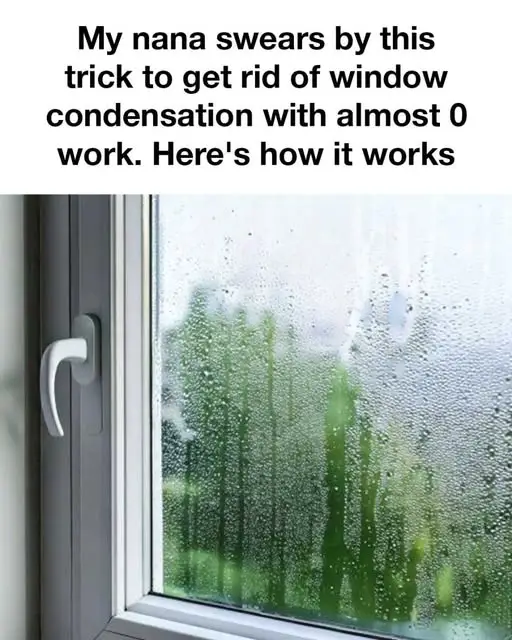Window condensation is one of those quiet household nuisances that most people ignore—until it starts causing visible damage. If you’ve ever woken up on a chilly morning to find water droplets clouding your windows or dripping onto the sill, you’re not alone. This common problem affects countless homes, especially during the cold season. But what if the solution was so simple and low-maintenance that it almost felt like cheating?
This is exactly what happened when my nana shared her timeless trick—a method so easy, effective, and inexpensive that I couldn’t believe I hadn’t thought of it myself. Here’s everything you need to know about tackling window condensation with minimal effort.
💧 What Causes Window Condensation?
Before diving into the solution, it’s important to understand what causes condensation in the first place. When warm, humid air inside your home meets a colder surface like a windowpane, the moisture in the air condenses into tiny water droplets. This typically happens during the fall and winter months when there’s a big difference between indoor and outdoor temperatures.
Condensation may seem harmless, but it’s more than just a foggy view. If left untreated, it can lead to:
- Mold growth on windows, walls, and sills
- Rotting window frames
- Peeling paint or wallpaper
- Damage to drywall or insulation
- Increased allergy or respiratory issues from mold spores
👵 Nana’s Trick: A Moisture Absorber That Works Like Magic
My nana’s go-to solution? Place a small dehumidifier or moisture absorber near the windows. That’s it. No fancy tools, no technical installations, no expensive remodeling. Just a smart placement of the right tool in the right spot.
She uses a compact moisture absorber filled with silica crystals or activated charcoal, and she swears by it. After a few days, you’ll start noticing significantly less moisture on your windows—sometimes none at all.
🧰 Step-by-Step Guide to Putting This Trick into Action
Here’s how you can implement this no-fuss remedy in just a few minutes:
- Purchase a Small Dehumidifier or Moisture Absorber
Choose a portable unit that fits near your window sill. If you prefer a non-electric solution, opt for moisture-absorbing crystals or desiccant packs. - Place It Close to the Problem Area
Position it right next to or below the window where condensation forms most frequently. The closer it is to the source, the more effective it will be. - Check the Device Regularly
Empty the water reservoir of electric dehumidifiers every few days or replace the crystals if using a disposable moisture absorber. - Observe the Results
Within a few days, you’ll likely notice a drastic reduction in window moisture. Your frames stay dry, your view stays clear, and mold won’t stand a chance.
🔬 Why This Trick Works So Well
It all comes down to controlling indoor humidity levels. Dehumidifiers and absorbers pull excess moisture from the air, lowering the chance that water will settle on your windows.
Most homes aim to maintain relative indoor humidity between 30% and 50%. Anything higher, especially during winter, will result in condensation forming on cold surfaces. By using nana’s trick, you’re keeping the air drier and the environment less favorable for mold and mildew.
💡 Additional Tips to Prevent Window Condensation
To take your efforts even further, combine nana’s trick with a few additional practices:
- Ventilate regularly: Use exhaust fans in the kitchen and bathroom, and open windows briefly each day (even in winter) to release trapped moisture.
- Seal leaks: Check for cracks or gaps around windows and doors. Use weather stripping or caulk to seal them up.
- Use thermal curtains: These help insulate windows and reduce cold surfaces, which lowers the risk of condensation forming.
- Limit indoor drying of laundry: Wet clothes release a surprising amount of moisture into the air.
- Upgrade your windows: Double or triple-glazed windows provide better insulation and stay warmer on the inside, reducing condensation dramatically.
🚫 Mistakes to Avoid
Even with a reliable trick like this, some common missteps can reduce its effectiveness:
- Letting the dehumidifier overflow: If the reservoir gets too full, it can stop working properly. Set reminders to empty it regularly.
- Using the wrong size: A dehumidifier that’s too small for the room won’t make a noticeable difference.
- Placing it too far away: The closer it is to the affected area, the better it works.
- Ignoring poor ventilation: Even the best dehumidifier won’t help if the air in your home has nowhere to circulate.
✅ Why This Trick Is Worth It
What makes this method truly great is its simplicity and low cost. There’s no need to replace windows, hire contractors, or commit to labor-intensive solutions. You can pick up a quality moisture absorber or small dehumidifier for under $25, and it will continue working for weeks or even months with minimal effort.
For people who don’t want to constantly wipe windows, invest in costly renovations, or tolerate mold risks, this is a game-changer.
🏡 Final Thoughts: The Power of Simple Home Wisdom
Some home maintenance tricks are complicated and expensive. This isn’t one of them. Nana’s moisture-control method is proof that sometimes, the most effective solutions are also the simplest.
By using a basic dehumidifier or moisture absorber near your windows, you can stop condensation in its tracks, protect your home from damage, and improve your indoor air quality—all without breaking the bank or lifting more than a finger.
So next time you see foggy glass on a cold morning, just remember: you don’t have to live with it. You just need a little trick from Nana.

